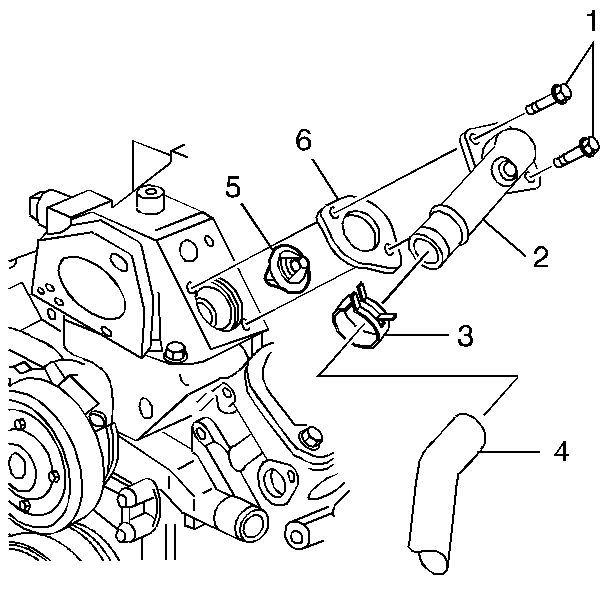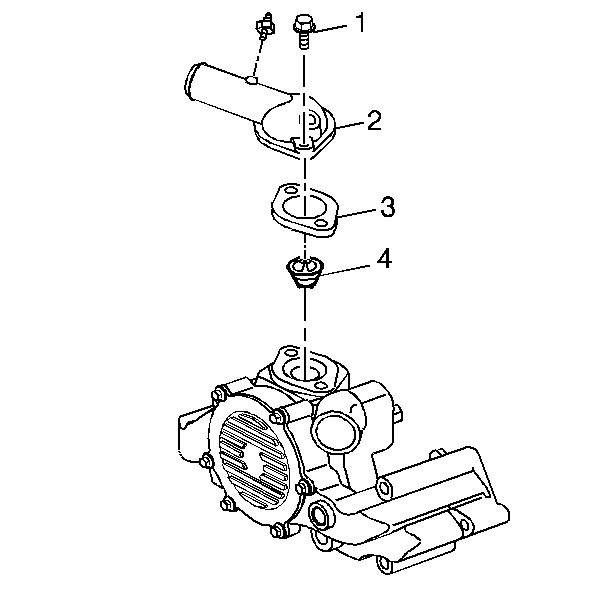Engine Coolant Thermostat Replacement 3800 VIN K
Removal Procedure
- Open the radiator drain cock. Drain the engine coolant from the radiator to a level below the thermostat. Refer to Cooling System Draining and Filling .
- Close the radiator drain cock.
- Remove the EGR valve outlet pipe bolts/screws from the upper intake and the EGR valve adapter.
- Remove the EGR valve outlet pipe.
- Loosen the hose clamp (3).
- Remove the inlet hose (4) from the water outlet.
- Remove the water outlet bolts/screws (1).
- Remove the water outlet (2).
- Remove the water outlet gasket (6).
- Remove the engine coolant thermostat (5).
- Clean the gasket surfaces of the water outlet and upper intake manifold.
Notice: When adding coolant, use DEX-COOL® coolant. If silicated coolant is added to the system, premature engine, heater core or radiator corrosion may result. In addition, the engine coolant will require change sooner-at 50 000 km (30,000 mi) or 24 months.
Notice: Use the correct fastener in the correct location. Replacement fasteners must be the correct part number for that application. Fasteners requiring replacement or fasteners requiring the use of thread locking compound or sealant are identified in the service procedure. Do not use paints, lubricants, or corrosion inhibitors on fasteners or fastener joint surfaces unless specified. These coatings affect fastener torque and joint clamping force and may damage the fastener. Use the correct tightening sequence and specifications when installing fasteners in order to avoid damage to parts and systems.
Tighten
Tighten the radiator drain cock to 1.5 N·m (13 lb in).

Installation Procedure
- Install the engine coolant thermostat (5) into the upper intake manifold.
- Install a new water outlet gasket (6).
- Install the water outlet (2).
- Install the water outlet bolts/screws (1).
- Install the inlet hose (4) to the water outlet.
- Tighten the hose clamp (3).
- Install the EGR valve outlet pipe.
- Add engine coolant, if required. Refer to Cooling System Draining and Filling .
- Start the engine.

Notice: Use the correct fastener in the correct location. Replacement fasteners must be the correct part number for that application. Fasteners requiring replacement or fasteners requiring the use of thread locking compound or sealant are identified in the service procedure. Do not use paints, lubricants, or corrosion inhibitors on fasteners or fastener joint surfaces unless specified. These coatings affect fastener torque and joint clamping force and may damage the fastener. Use the correct tightening sequence and specifications when installing fasteners in order to avoid damage to parts and systems.
Tighten
Tighten the water outlet bolts/screws (1) to 27 N·m (20 lb ft).
Install the EGR valve outlet pipe bolt/screw to the upper intake manifold and the EGR valve adapter.
Notice: When adding coolant, use DEX-COOL® coolant. If silicated coolant is added to the system, premature engine, heater core or radiator corrosion may result. In addition, the engine coolant will require change sooner-at 50 000 km (30,000 mi) or 24 months.
Tighten
| • | Tighten the EGR valve outlet pipe bolt/screw to the upper intake to 25 N·m (18 lb ft). |
| • | Tighten the EGR valve outlet pipe nut to the EGR valve adapter to 29 N·m (21 lb ft). |
After the engine reaches normal operating temperature, inspect for coolant leaks.
Engine Coolant Thermostat Replacement 5.7L VIN P
Removal Procedure
- Open the radiator drain cock.
- Close the radiator drain cock.
- Remove the air intake duct.
- Remove the air cleaner.
- Remove the inlet hose and the clamp from the water outlet.
- Remove the water outlet bolt/screw from the water pump.
- Remove the water outlet.
- Remove the water outlet gasket.
- Remove the engine coolant thermostat.
- Clean the gasket surfaces of the water outlet and the water outlet pump.
Drain the engine coolant from the radiator to below the level of the engine coolant thermostat.
Notice: Use the correct fastener in the correct location. Replacement fasteners must be the correct part number for that application. Fasteners requiring replacement or fasteners requiring the use of thread locking compound or sealant are identified in the service procedure. Do not use paints, lubricants, or corrosion inhibitors on fasteners or fastener joint surfaces unless specified. These coatings affect fastener torque and joint clamping force and may damage the fastener. Use the correct tightening sequence and specifications when installing fasteners in order to avoid damage to parts and systems.
Tighten
Tighten the radiator drain cock to 1.5 N·m (13 lb in).

Installation Procedure
- Install the engine coolant thermostat into the water pump.
- Install the new water outlet gasket.
- Install the water outlet.
- Install the water outlet bolt/screw.
- Install the inlet hose and the clamp to the water outlet.
- Install the air cleaner.
- Install the air cleaner duct.
- Add engine coolant, if required. Refer to Cooling System Draining and Filling .
- Start the engine.

Notice: Use the correct fastener in the correct location. Replacement fasteners must be the correct part number for that application. Fasteners requiring replacement or fasteners requiring the use of thread locking compound or sealant are identified in the service procedure. Do not use paints, lubricants, or corrosion inhibitors on fasteners or fastener joint surfaces unless specified. These coatings affect fastener torque and joint clamping force and may damage the fastener. Use the correct tightening sequence and specifications when installing fasteners in order to avoid damage to parts and systems.
Tighten
Tighten the water outlet bolt/screw to 28 N·m (21 lb ft).
Notice: When adding coolant, use DEX-COOL® coolant. If silicated coolant is added to the system, premature engine, heater core or radiator corrosion may result. In addition, the engine coolant will require change sooner-at 50 000 km (30,000 mi) or 24 months.
After the engine reaches normal operating temperature, inspect for leaks.
